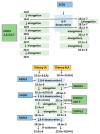Genes and Dietary Fatty Acids in Regulation of Fatty Acid Composition of Plasma and Erythrocyte Membranes
- PMID: 30453550
- PMCID: PMC6265745
- DOI: 10.3390/nu10111785
Genes and Dietary Fatty Acids in Regulation of Fatty Acid Composition of Plasma and Erythrocyte Membranes
Abstract
The fatty acid compositions of plasma lipids and cell membranes of certain tissues are modified by dietary fatty acid composition. Furthermore, many other factors (age, sex, ethnicity, health status, genes, and gene × diet interactions) affect the fatty acid composition of cell membranes or plasma lipid compartments. Therefore, it is of great importance to understand the complexity of mechanisms that may modify fatty acid compositions of plasma or tissues. We carried out an extensive literature survey of gene × diet interaction in the regulation of fatty acid compositions. Most of the related studies have been observational studies, but there are also a few intervention trials that tend to confirm that true interactions exist. Most of the studies deal with the desaturase enzyme cluster (FADS1, FADS2) in chromosome 11 and elongase enzymes. We expect that new genetic variants are being found that are linked with the genetic regulation of plasma or tissue fatty acid composition. This information is of great help to understanding the contribution of dietary fatty acids and their endogenic metabolism to the development of some chronic diseases.
Keywords: FADS; diet; fatty acid; genotype; human.
Conflict of interest statement
The authors declare no conflict of interest.
Figures



References
-
- Hunter D. Biochemical indicators of dietary fat. In: Willett W., editor. Nutritional Epidemiology. Oxford University Press; Oxford, UK: 1990.
-
- Vessby B., Lithell H., Gustafsson I.B., Boberg J. Changes in the fatty acid composition of the plasma lipid esters during lipid-lowering treatment with diet, clofibrate and niceritrol. reduction of the proportion of linoleate by clofibrate but not by niceritrol. Atherosclerosis. 1980;35:51–65. doi: 10.1016/0021-9150(80)90027-1. - DOI - PubMed
Publication types
MeSH terms
Substances
Grants and funding
LinkOut - more resources
Full Text Sources
Medical

